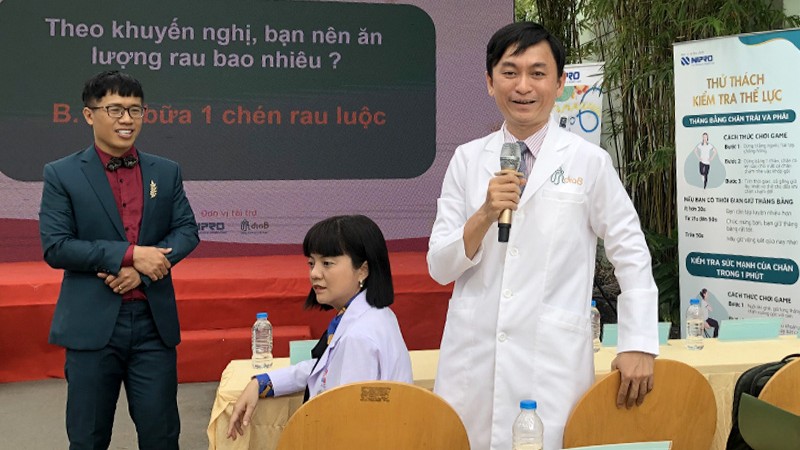For over 20 years practicing in endocrinology and diabetes, Dr. Ly Dai Luong (MD, PhD) has witnessed the sweeping changes in Vietnamese healthcare, from the days of handwritten prescriptions and paper records to the digital era of electronic medical charts, digital signatures, and remote monitoring of patients’ blood sugar, blood pressure, diet, and exercise data.

For him, digital transformation in healthcare didn’t start with technology, but with a deeply human concern:
“Patients only see their doctors about 1% of the time. The other 99%, are left to manage their illness on their own. So how can healthcare professionals extend their care into patients’ daily lives?”
After more than two decades of treating people with diabetes, when did you realize that the traditional model of consultation, prescription, and follow-up was no longer sufficient?
The number of people living with diabetes in Vietnam has doubled every decade, yet only about 30% achieve adequate glycemic control. When we look at comprehensive management (meaning optimal control of blood glucose, blood pressure, and lipids), only 12–15% of patients meet all three targets.
In reality, patients spend only about 1% of their time with their doctors; the remaining 99% of diabetes management happens at home. During those brief clinic visits, physicians can address acute issues but rarely have time to explore a patient’s lifestyle, daily habits, or emotional state. All of which critically affect treatment outcomes.
I often say healthcare should learn from the banking sector: they’ve brought “the bank into your living room.” Medicine must do the same, bringing healthcare into people’s homes. To improve outcomes, we need to understand how patients live: what they eat, how they sleep, how much they move, and why they struggle to follow medical advice.
Digital transformation allows us to extend that reach. With connected devices, digital platforms, and continuous data, physicians can gain a clearer picture of patients’ real-world behaviors and use that understanding to guide more personalized, sustainable lifestyle changes.
In your view, what is the biggest challenge for people with diabetes in Vietnam?
The biggest challenge is loneliness in treatment.
Health information today is everywhere, from TikTok to YouTube, yet patients don’t know what is credible and suitable to them. Some hear that guava leaf tea or bitter melon can lower blood sugar and try it. Meanwhile, many who have been in treatment for years still don’t know what HbA1c actually means.

They need someone to accompany them to help interpret lab results, explain why lifestyle change matters, and support them in making those changes. Social media floods them with information, but no one sits down to listen and guide them step by step. That’s exactly where technology, when applied responsibly, can fill the gap.
To you, what does “digital transformation” in healthcare truly mean?
It doesn’t have to start with large-scale projects or complex systems. Every doctor can begin digitizing within their own practice.
For instance, when patients use smartwatches or continuous glucose monitors, their data is automatically collected. By the time they come back for follow-up, I already have their full record — glucose levels, sleep patterns, physical activity. I no longer waste time asking, “What was your blood sugar yesterday?” Instead, I can spend more time listening, explaining, and supporting them.
That, to me, is the essence of digital transformation: freeing doctors from repetitive administrative work so we can focus on caring for the human being behind the data.
Why do you think digital transformation in Vietnam’s healthcare is still slow?
There are three main reasons: infrastructure, legal framework, and systemic thinking.
On the surface, Vietnam’s healthcare system looks modern—many hospitals have electronic medical records, online appointment systems, and digital payments. Yet, these systems operate in isolation. Each hospital uses its own HIS platform, often built by different vendors, some no longer active, making maintenance and integration almost impossible. As a result, patient data is fragmented: a person treated at Hospital A must redo everything at Hospital B—from filling out forms to lab tests.
Secondly, the legal framework is still being refined. Although the foundation exists, doctors, patients, and developers are still “feeling their way forward.” Doctors hesitate to offer online consultations; patients worry about data privacy; companies fear being seen as overstepping regulations.
A well-defined legal corridor would not only protect all three parties but also enable health content regulation and standardization, so patients no longer have to “swim” through a sea of unverified health information.
Finally, there’s the lack of systemic thinking. A patient is not a single episode of illness but a continuous flow of health data throughout life. Only when we see healthcare as an interconnected, responsibly managed data ecosystem can digital transformation truly go deep and make lasting impact.
From your own experience, what have you learned while developing DiaB and working on digital transformation?
My motivation started with a simple professional concern: the rate of well-controlled diabetes in Vietnam remains low. Life expectancy is increasing, but data from the World Health Organization shows that many Vietnamese spend their final decade in poor health, living with complications like stroke, heart disease, kidney failure, or vision loss. I kept asking myself: How can we help patients not only live longer but live well, independently, and with dignity?
Traditional clinical models aren’t enough. But technology, through platforms like DiaB, can extend the doctor’s reach. It helps patients understand their lifestyle — exercise, sleep, stress levels — and provides timely reminders and feedback.
When patients feel they can manage their condition, they become more engaged and consistent in treatment. Hospitals partnering with DiaB have reported higher follow-up rates, simply because patients feel supported every day.
The hardest part of developing DiaB was balancing medical rigor with usability. A clinically perfect app might demand dozens of data points, but that complexity drives patients away. We chose to simplify, focusing only on the most clinically meaningful indicators.
More importantly, DiaB maintains the human element through a peer support model, where patients share their real experiences what they struggle with and how they stay motivated while doctors monitor and offer guidance. This model currently runs on patients’ voluntary participation and follows examples from international healthcare systems. But since Vietnam still lacks a legal framework for such data-sharing and peer interaction, all stakeholders — doctors, developers, and patients — proceed cautiously.
I believe once a clear legal framework is in place, responsibilities and rights will be better defined and safer for everyone. Only then can models like DiaB realize their full potential: technology connects us, but it’s people who make healthcare humane.
What is the hardest part of helping patients change their habits, and how does technology help?
The hardest part is building motivation.
For people with diabetes, medication is only a small piece of the puzzle. Success depends far more on whether they’re willing to change how they eat, move and live, and that motivation must come from within.
Technology can collect, analyze, and explain data, but the power to change lies with the patient. I once had a patient who refused to take medicine more than one a day, no more. In that case, the challenge wasn’t medical. It was emotional and psychological.
No technology can replace human interaction, listening, comforting, encouraging, and understanding why patients resist change. Then, slowly, with patience, helping them adjust. Digital tools automate data collection, giving me more time for the human part: to ask, talk, and motivate.

That also means doctors must learn to communicate with empathy and clarity to inspire patients to want to change, not merely feel they have to. Technology can’t do that for us, but it gives us the time and space to do it better.
Is there any aspect of healthcare that should not, or cannot, be fully digitized?
Yes, it’s the act of clinical decision-making.
Technology can rapidly gather and organize data—biometrics, lab results, medical history—and AI can even analyze and suggest potential diagnoses or treatment plans. But the final decision must always rest with the doctor.
No one wants ChatGPT or Google Gemini to prescribe their medication. Even for me, I want to read, interpret, and weigh the data myself, combining information, experience, and each patient’s unique context.
Digital transformation and AI should be seen as decision-support tools, not replacements. The doctor remains the final gatekeeper—connecting data, knowledge, and empathy to deliver care that is both accurate and human. That’s the boundary and the value that technology can never replace.
How will the roles of doctors and patients evolve over the next decade as technology becomes more integrated into healthcare?
Patients today are smarter and more proactive. They read, research, and even challenge doctors:n“ChatGPT says I shouldn’t take this drug—why did you prescribe it?”
And I think that’s a good thing. When patients ask questions, it means they care more about their health. But it also means doctors must be more knowledgeable and confident, ready to explain, reason, and persuade with sound medical understanding.
Technology gives patients access to knowledge; doctors must now be even better at ensuring that knowledge is used wisely.
What does Vietnam need to make digital transformation in healthcare more than just a slogan?
First, a clear and enforceable legal framework. We need defined boundaries on what can and cannot be done, so doctors, tech companies, and patients all operate safely.
Second, standardized and connected data infrastructure. Only when healthcare providers, developers, and regulators agree on shared standards for data and interoperability can digital transformation truly accelerate. When I studied and worked in South Korea, my medical data was always available in the system whether I visited a hospital or a private clinic. Any authorized facility could access it, saving time and improving diagnostic accuracy.
Finally, training and upskilling healthcare professionals. Medical schools are beginning to adapt, encouraging students to learn how to use technology and AI as tools in clinical practice. Because in the near future, doctors won’t just need strong medical expertise, they’ll also need data literacy.

I may be an ordinary doctor, but I hope these reflections reach policymakers and institutions. If we can build real connections between hospitals, developers, and regulators, then digital transformation in Vietnam’s healthcare will no longer be a slogan, but a sustainable foundation for the future.
Hosted by Vietnam Innovators Digest, the Healthcare Summit 2025 themed by “Making Vietnam an Innovation Hub through Healthcare” will bring together healthcare leaders, investors, policymakers and innovators. This year's summit will be a dynamic convergence focused on healthcare innovation, investment and accessibility through digital health solutions. We will explore how investment and innovation can accelerate the healthcare transformation in Vietnam and beyond.
Date and Time: 9:00 AM - 4:00 PM, 24 October, 2025
Location: Ho Chi Minh city (Venue to be updated soon)
Event details: find out more HERE
Special thanks to our sponsors & partners for accompanying us in this event:
Pharmacity (Major Partner); HSBC, DKT Mekong, Bayer (Engagement Partner); JW Marriott Hotel & Suites Saigon (Venue Partner) , Vietcetera (Media Partner); UK Embassy, Britcham Vietnam, Hello Bacsi (Communications Partner).

